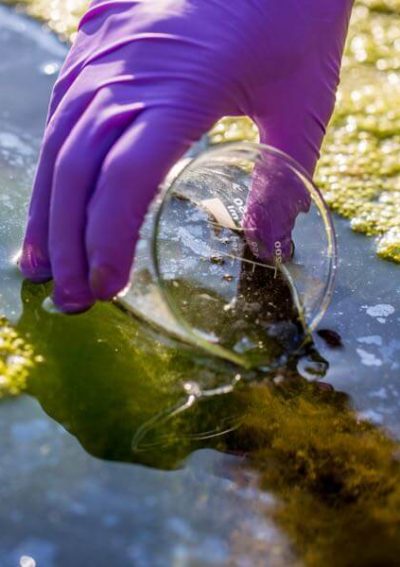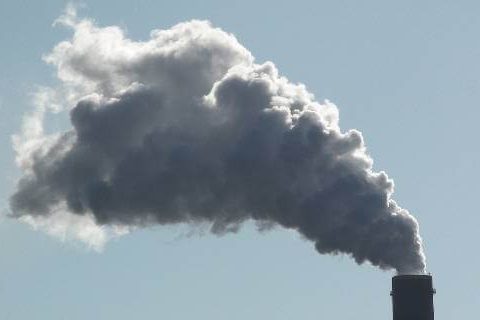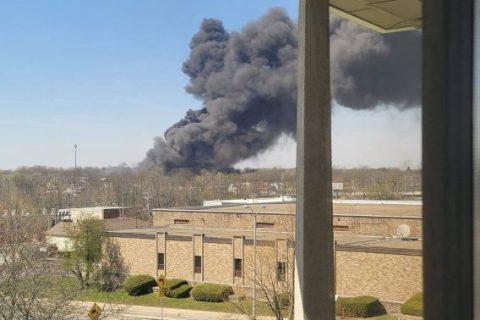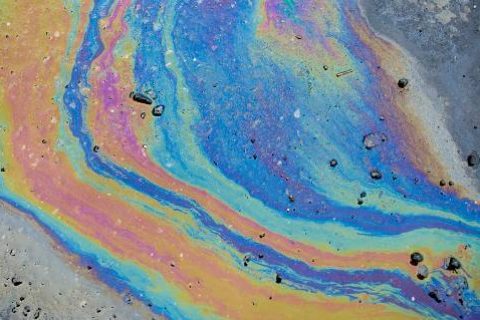Environmental Health
Most people recognize healthy eating and exercise contribute to good health. But preventable environmental factors can also impact your well-being. Staying informed of potential environmental hazards can empower you to take action to protect yourself and your family.

Environmental safety is something most of us take for granted. We assume the water we drink is safe, the air we breathe is clean and the food we eat is free of contaminants. But that’s not always the case.
Chemicals and biological pathogens such as bacteria, viruses and parasites are everywhere and can easily migrate through air, water and soil.
Most of the time, we’re unaware of the substances we’re inhaling, swallowing or touching. And even when we are aware, the risks of exposure to these substances are often unknown. But in some instances, they can be hazardous to our health and safety, causing serious injury and illness.

Water Contamination
Contaminated water is the leading cause of disease and death around the world, according to the World Health Organization. Approximately 3.4 million people die from water-related diseases every year, mostly in the developing world.
But as the water crisis in Flint, Michigan, showed, no corner of the globe is immune. The highly publicized tragedy began in 2014 when officials in Flint decided to stop getting the city’s water from Lake Huron and instead source it from a local river to save money.
After the switch, foul-smelling brown water flowed from taps and alarmed residents. City officials insisted the water was safe.
But by late 2015, children in Flint began developing elevated levels of lead in their blood, which officials eventually linked back to the water. Investigations showed water from the river had not been properly treated with corrosion-control chemicals. As a result, lead from aging pipes had leached into the water supply.
Tainted water from the river also sparked a deadly outbreak of Legionnaires’ disease that killed 12 Flint residents and sickened nearly 90. Scientists believe inadequate chlorination of the water caused the Legionnaires’ outbreak.
Top Sources of Water Contamination
While inadequate chlorination and aging pipes may be to blame for the crisis in Flint, agriculture continues to be one of the top sources of water contamination in the United States.
Nutrients from fertilizers can easily contaminate groundwater and lead to harmful algae blooms such as the red tide events that have affected Florida’s coastline. Animal waste and antibiotics and hormones used on livestock can also end up in waterways. Other contaminants include heavy metals used to boost the growth of animals and salt from manure.
Naturally occurring heavy metals such as arsenic, fluorides and iron can also leach into groundwater. Some of these substances can change the taste, smell or color of the water. Others may make people sick if they’re exposed to too much.
Per- and polyfluoroalkyl chemicals also contaminate water through various sources. Industrial sites have dumped it into natural bodies of water. Landfills leak it into groundwater. It also ends up in water through contaminated products.
Potential sources of water contamination can include:
- Agricultural runoff
- Improper hazardous waste disposal
- Improperly constructed or abandoned wells
- Industrial and mining activities
- Landfill leakage
- Leaking sewer pipes
- Leaking underground storage systems for chemical or petroleum products
- Leakage from nuclear power plants
- Per- and polyfluoroalkyl substances
- Poorly constructed irrigation wells
- Releases or spills from stored industrial waste
- Septic tanks
- Urban runoff from cities and parking lots
Improper waste disposal and leakage from underground storage tanks and nearby businesses caused toxic chemicals to contaminate the water supply at military base Camp Lejeune from 1953 to 1987. Everyone who lived and worked on base during that time was exposed to water contaminated with toxic chemicals including dry cleaning solvents, degreasers, heavy machinery chemicals and about 70 other toxic substances.
The most toxic chemicals include benzene, vinyl chloride, tetrachloroethylene and trichloroethylene. Studies have linked these chemicals to various cancers and other health problems. People who suffered medical problems after contaminated water exposure on base may be eligible to file a Camp Lejeune lawsuit for compensation.
Tips to Reduce Water Pollution
While many causes of water contamination are beyond your control, there are several actions you can take to help reduce pollution in your waterways.
- NEVER pour cooking fat, oil or grease into your sink. Store fats in a jar and discard the jar along with other solid waste when it gets full.
- AVOID flushing medications down the toilet. Dispose of your unused drugs at a National Prescription Drug Take-Back event or deposit in them in your regular household trash.
- NEVER flush household chemicals down the sink. Check with your local sanitation department for proper places to deposit chemical waste.
- Only use phosphate free soaps and detergents and use only the minimum amount of detergent or bleach on clothes and dishes.
- AVOID putting solid food waste into the garbage disposal. Toss the waste in the trash or consider making compost from vegetable scraps instead.
- AVOID flushing tissue, dust cloths and other paper goods down the toilet.
- Minimize your use of fertilizer and pesticides. And don’t flush these chemicals or others into the sewer systems.
- Recycle oil filters, motor oil and other fluids at vehicle service centers. A list of participating stores is available at www.earth911.com or by calling 1-800-CLEANUP.
- Wash your car on the lawn, not the pavement.
- Clean up after your pet.
- Check to make sure your sump pump or cellar drain is not connected to the sanitary sewer system.
- Call your lawmakers and government regulators to tell them you support clean water protections.
What to Do During a Water Emergency
If a water emergency does occur, follow any boil water warnings or any other advisories you receive. Don’t drink or use the tap water until your utility company tells you it is safe to do so.
All community water suppliers must submit an annual report to customers on the quality of their drinking water by July 1 of every year. This Consumer Confidence Report, or CCR, tells you where your water comes from and lists levels of particular contaminants found in your drinking water. You may be able to find your CCR through the EPA, though CCRs for all water systems may not be available.
If your water tastes or smells strange, or doesn’t look right, call your water utility company. You can also contact a state certified water laboratory in your area to perform a test if you suspect contamination.

Air Pollution
Poor air quality — both indoor and outdoor — poses a significant risk to human health. Chronic exposure to air pollution is linked to cancer, long-term damage to the respiratory and cardiovascular systems, and early death.
Each year, one in nine deaths worldwide result from air pollution. Those most at risk include children, the elderly, minorities and people with a low income or preexisting health conditions.
Air pollution can contribute to the hardening and narrowing of arteries, according to the American Heart Association. The condition, known as atherosclerosis, can lead to heart attacks and strokes. Even short-term exposure to pollution can have catastrophic effects on a person with preexisting heart conditions.
According to the National Park Service, there are four main sources of air pollution:
- Area Sources
- Farms, cities and wood-burning fireplaces emit small amounts of pollution on their own, but it can add up to a lot.
- Mobile Sources
- Vehicles, trains and airplanes are responsible for more than half of all the air pollution in the country.
- Natural Sources
- Wildfires, volcanoes and dust storms can also generate air pollution.
- Stationary Sources
- Factories, oil refineries, power plants, sewage treatment plants and other stationary sources are known as “point sources” of pollution.
Indoor Pollutants
Common causes of indoor air pollution include mold, pollen, tobacco smoke and per- and polyfluoroalkyl substances. PFAS occur indoors as vapors or fine particles. They end up in the air by breaking off fabrics and carpet.
Other sources include household products, dangerous gases and harmful building materials.
Radon Gas
Long-term exposure to radon gas can cause lung cancer. In fact, radon exposure is the second-leading cause of lung cancer in the United States after cigarette smoking.
Radon is invisible and odorless and comes from the natural breakdown of uranium, which is found in soil, rocks and water. It can enter your home through cracks in the floor or foundation and build up to high levels.
The only way to know whether your house has high radon levels is to test it. You can hire someone to do this, or buy a kit and do it yourself. If you do find high levels of radon, it’s wise to invest in a radon reduction system.
Asbestos
Older houses, schools and buildings built between 1930 and 1950 may contain asbestos. Asbestos-containing materials such as ceiling tiles, floor tiles and shingles can release asbestos fibers into the air if the materials are sawed, scraped, sanded or otherwise disturbed or destroyed.
Inhaling asbestos fibers can lead to lung cancer and mesothelioma, a rare cancer of the lining of the chest and abdominal cavity. People who breathe in large amounts of asbestos can also develop asbestiosis, an inflammation and scarring of the lungs.
According to the U.S. Consumer Product Safety Commission, an asbestos professional can help you determine if you have an asbestos issue and suggest the best way to handle it.
Chinese Drywall
The Consumer Product Safety Commission has received more than 4,000 consumer complaints related to drywall produced in China. Consumers say they developed health problems from the material. They also say it caused electrical wiring and metal components in their homes to corrode.
Fifty-six percent of the complaints came from Florida, and most involved homes constructed between 2006 and 2007 in the aftermath of two busy hurricane seasons. Many consumers noted a strong sulphur smell in their homes similar to rotten eggs.
Reported health problems from Chinese drywall include:
- Skin and eye irritation
- Trouble breathing
- Ongoing cough
- Bloody or runny nose
- Asthma attacks
- Frequent headaches
- Sinus infection

Impacts of Oil, Gas and Energy Production
Industrial activities and accidents are another cause of environmental health hazards. And the impact of the energy sector is profound.
According to the U.S. Energy Information Administration, nearly 70% of the electricity generated in 2016 came from burning plants or fossil fuels that create an array of harmful byproducts.
According to the Energy Information Administration, emissions from these power plants include:
- Carbon Dioxide (CO2)
- A greenhouse gas that contributes to climate change
- Sulfur Dioxide (SO2)
- Causes acid rain and respiratory problems in humans
- Nitrogen Oxides (NOx)
- A contributor to ground level ozone, a known lung irritant
- Particulate Matter (PM)
- Contributes to lung problems, such as asthma, emphysema and lung cancer
- Mercury and Other Heavy Metals
- Can be toxic to humans and animals
From oil spills in the Gulf of Mexico to gas leaks in California to earthquakes in Oklahoma, the oil and gas industry is also a contributor to environmental disasters. And although rare, nuclear accidents can cause devastating effects with no easy fixes.
Wastewater Disposal
Domestic oil and gas production reached new highs in recent years thanks to the controversial extraction technique known as hydraulic fracturing, or “fracking.” The drilling process involves blasting a mixture of water, sand and chemicals deep into cracks in the ground to release trapped gas and oil from shale rock.
But the high-pressure extraction technique has serious environmental consequences. Fracking requires millions of gallons of water and generates enormous amounts of wastewater that can leak into soil and local water resources.
Companies dispose of fracking wastewater by injecting it into deep underground wells. But experts say this disposal process is causing an increase in earthquakes in Oklahoma, Texas and other places where fracking is common. Some of those earthquakes have damaged homes and other buildings.
“The injection of wastewater and salt water into the subsurface can cause earthquakes that are large enough to be felt and may cause damage,” according to the U.S. Geological Survey.
In 2009, Oklahoma registered on average about one or two earthquakes per year. Today, the Sooner State is a hotbed of earthquakes, with hundreds occurring each year. One of those quakes, which struck near a city called Pawnee in 2016, measured 5.8 on the Richter scale. It was the largest earthquake ever recorded in Oklahoma. Earthquake activity is also up in north Texas.
“The injection of wastewater and salt water into the subsurface can cause earthquakes that are large enough to be felt and may cause damage.”
A 2017 study by researchers at Southern Methodist University concluded that the seismic activity is “more likely induced than natural.” Another 2017 study looking at the Pawnee earthquake notes that present “consensus” is that wastewater injection into Oklahoma’s deep sedimentary rocks is causing the tremors. According to that study, earthquake activity caused by water injection can occur as far away as 12.4 miles from an injection site.
Oil Spills
Accidental oil spills can wreak havoc on the environment. The largest offshore oil spill in United States history was the the 2010 explosion of Deepwater Horizon, a BP-operated drilling rig in the Gulf of Mexico. The explosion killed 11, injured 17 and spilled 210 million gallons of petroleum into the Gulf.
According to the National Ocean Service, the catastrophe affected 1,300 miles of shoreline and killed thousands of marine mammals and sea turtles. National Oceanic and Atmospheric Administration scientists found that the spill harmed the reproductive success of bottlenose dolphins off the coast of Louisiana and led to a 50% decline in population of the mammals.
The BP oil spill also took a toll on the economy. The fishing industry lost more than $94 million in 2010 and hundreds if not thousands of people lost their jobs.
Tourism took a big hit too. Leisure tourism spending in Louisiana declined by nearly $250 million in 2010 and hotels from Texas to Mississippi to Florida experienced a drop in bookings.
Scientists also noted increased levels of depression, anxiety and mental illness among residents affected by the spill for two years after the disaster.
Gas Leaks
In 2015, a leaking gas storage well in the north San Fernando Valley spewed more than 100,000 metric tons of methane into the air. The massive cloud of gas drifted from the Southern California Gas Company storage facility into the nearby neighborhood of Porter Ranch and prompted thousands of evacuations.
Methane itself isn’t particularly toxic to humans. But when methane and other chemicals in natural gas hit the open air, they can create an array of other hazardous chemicals, such hydrogen sulfide, according to researchers at the University of Southern California.
During and after the so-called “Porter Ranch gas leak,” thousands of residents exposed to the gas complained of headaches and other symptoms such has nausea, eye irritation and nosebleeds. Health investigators found that residents of nearly 50% of households within three miles of the leaking well experienced bloody noses.
While funding disputes have stymied a long-term study of health impacts of the gas leak, thousands of local residents have sued SoCalGas, alleging the company was negligent and should have prevented the leak from happening.
Nuclear Accidents
Nuclear energy is relatively clean, reliable and efficient. And since 1990, it’s supplied about 20% of the nation’s power, according to the Department of Energy’s Office of Nuclear Energy.
But as the Fukushima Daiichi nuclear disaster in 2011 demonstrated, when nuclear energy goes wrong, it can go very wrong. The accident occurred following a major earthquake and tsunami, which had shut down the power plant’s power supply and had disabled its critical cooling system.
Within three days, the plants three nuclear reactors melted down, several explosions occurred and radiation spewed into the air, soil and ocean. Thousands evacuated as a result and a massive cleanup effort is still ongoing. A handful of the 5,000 workers who toiled daily in the cleanup efforts have developed cancer and one even died.
In 2018, Tokyo Electric Power Company (TEPCO) employees who had been working on the plant’s cleanup reported finding lethal levels of radiation at the plant and said contaminated water was seeping into the ground. The ongoing cleanup is generating about 400 tons of contaminated water per day that’s being stored in containers around the disabled plant, according to the New York Times. The entire cleanup could take decades.
Fukushima was the most serious nuclear accident since the disaster at Chernobyl in 1986.

Toxic Pesticides
Farmers use more than 1,000 pesticides worldwide to protect crops from weeds, insects and other pests, according to the World Health Organization. And many pesticides are toxic to humans.
In some cases, exposure to large amounts of pesticides can cause poisoning or long-term harm such as cancer or reproductive health problems.
Agricultural laborers and others who work directly with pesticides are most susceptible to the toxic effects. But the everyday consumer encounters these chemicals in much lower levels through pesticide residue in food and water.
According to a 2016 article on chemical pesticides and human health in the journal Frontiers in Public Health, washing and peeling foods can’t entirely remove residues. And “safe limits” established by regulatory bodies may underestimate potential health risks because of chronic exposure to many chemicals.
“The combination of substances with probably carcinogenic or endocrine-disrupting effects may produce unknown adverse health effects."
“The combination of substances with probably carcinogenic or endocrine-disrupting effects may produce unknown adverse health effects,” the authors wrote. “Therefore, the determination of ‘safe’ levels of exposure to single pesticides may underestimate the real health effects, ignoring also the chronic exposure to multiple chemical substances.”
Roundup Controversy
A 2018 report by the Environment Working Group found elevated levels of glyphosate in Cheerios, granola bars and 29 other breakfast foods made from oats. The controversial herbicide is the main ingredient in Monsanto’s Roundup weed killer, the most-used pesticide in the world.
California scientists have said the weed killer can cause cancer in humans, and the World Health Organization has declared it a “probable” human carcinogen. A California jury agreed, and in 2018, it awarded $289 million in damages to a former school groundskeeper who claimed he had developed cancer after regular exposure to the chemical.
The Environmental Protection Agency, which regulates pesticide use in the United States, has said glyphosate is “not likely carcinogenic.” But hundreds of other Roundup lawsuits are pending against Monsanto, which is a division of Bayer AG.
Malathion Concerns
Malathion, an organophosphate, is another common pesticide under scrutiny. Farmers, residential landscapers and other workers in the United States use about 1 million pounds of the insecticide every year to control a range of pests.
Public health officials use it to get rid of mosquitoes. Others use it to combat fruit flies. It’s also a common ingredient in shampoos used to kill lice.
Accidentally inhaling or ingesting malathion can disrupt your nervous system and make you sick.
According to the Centers for Disease Control and Prevention, high levels of exposure to malathion may cause:
- Trouble breathing
- Tightness of the chest
- Vomiting, cramps and diarrhea
- Watery eyes and blurred vision
- Headaches and dizziness
- Increased salivation
- Sweating
- Loss of consciousness
- Death
Some studies have suggested a link between malathion exposure and possible developmental disorders in children. And the World Health Organization has classified the chemical as a “probable” carcinogen.
A 2017 “biological analysis” of the chemical by the EPA found that malathion is “likely to adversely affect” 97% of the federally protected species it comes in contact with.
In 2018, several conservation and public health groups sued the EPA, the U.S. Fish and Wildlife Service and the Department of Interior for “failing to protect endangered wildlife and the environment” from the “dangerous pesticide.”
Dicamba Crop Damage
A chemical called dicamba is also generating controversy. The 1960s-era herbicide controls weed growth in certain grain crops, grasslands and pastures. But because many plants are extremely sensitive to the toxic weed killer, the EPA for many years only permitted dicamba spraying on fields before they were planted.
That changed in 2017 when Monsanto Co. and the German chemical company BASF introduced a less volatile formulation of dicamba alongside new varieties of soybean and cotton seeds that had been genetically altered to tolerate the herbicide.
The idea was to provide an alternative to Roundup because weeds were becoming resistant to it. Many farmers jumped on board and planted 25 million acres of the new seed varieties.
But there was a problem.
Dicamba doesn’t always stay put and when the chemical drifted into neighboring farms that weren’t using dicamba-resistant seeds, it devastated their crops.
Since 2017, farmers in 17 states have filed more than 1,400 complaints regarding 2.5 million acres of damaged crops. Many filed dicamba lawsuits against Monsanto that claimed the company acted recklessly and should have warned them about the potential dangers of the herbicide.
Using Pesticides Safely
Most pesticides can pose a risk to humans and animals. If you are using a pesticide in or around your home, be sure to read and follow all label instructions on the product.
The National Pesticide Information Center also recommends doing the following:
- Ensure pets, children and other sensitive people are not near the area where you are mixing or applying pesticides.
- Only mix pesticides outside or in areas with good ventilation.
- Wear protective clothing such as long pants, a long-sleeved shirt and closed-toe shoes.
- Have paper towels, sawdust or cat litter, garbage bags and non-absorbent gloves on hand in case you have to clean up a spill.
- Mix only what you need to use to avoid having to store or dispose of excess chemicals.
- Stay out of treated areas for the amount of time recommended on the label.
In the event of a pesticide emergency, call 911 and the Poison Control Centers’ national hotline phone number, 1-800-222-1222. If your pet is poisoned, get emergency advice from the ASPCA Animal Poison Control Center at 888-426-4435. A $65 consultation fee may apply. You can also call the Pet Poison Helpline at 800-213-6680 and receive help for $59.
PFAS Concerns
Per- and polyfluoroalkyl substances include around 5,000 chemicals. They’re known as “forever chemicals” because they don’t degrade. Most people have come in contact with these substances through water, food or consumer products.
Researchers have linked PFAS to fertility problems, certain cancers and other health risks. It may cause kidney and testicular cancer, ulcerative colitis and developmental problems.
You may have clothing or products containing PFAS in your house. They have polluted soil and have been a major cause of water contamination. Many pesticides have contained dangerous levels of PFAS.
The U.S. Environmental Protection Agency sets lifetime exposure limits for PFAS. While the limit is set for drinking water, the agency considers other sources of exposure to PFAS, including food and consumer products.
In June 2022, the agency updated the lifetime exposure limits for four types of PFAS. It recommends drinking water should contain no more than 0.004 parts per trillion for PFOA (perfluorooctanoic acid) and 0.02 ppt for PFOS (perfluorooctane sulfonic acid). For PFBS (perfluorobutane sulfonic acid) and HFPO (hexafluoropropylene oxide), it recommends 2,000 ppt and 10 ppt, respectively.
83 Cited Research Articles
Consumernotice.org adheres to the highest ethical standards for content production and references only credible sources of information, including government reports, interviews with experts, highly regarded nonprofit organizations, peer-reviewed journals, court records and academic organizations. You can learn more about our dedication to relevance, accuracy and transparency by reading our editorial policy.
- Agency for Toxic Substances & Disease Registry. (2003, September). Toxic Substances Portal — Malathion. Retrieved from https://wwwn.cdc.gov/TSP/PHS/PHS.aspx?phsid=520&toxid=92
- American Heart Association. (2015, July 31). Air Pollution and Heart Disease, Stroke. Retrieved from https://www.heart.org/en/health-topics/consumer-healthcare/what-is-cardiovascular-disease/air-pollution-and-heart-disease-stroke
- Arcadia Power. (n.d.). The Main Causes of Water Pollution in the U.S. Retrieved from https://blog.arcadia.com/main-causes-water-pollution-u-s/
- Arnold, J. (n.d.). Chemical Warfare. Retrieved from https://www.emedicinehealth.com/chemical_warfare/article_em.htm#risk_of_exposure_to_chemical_weapons
- Bellon, T. (2018, July 11). Lawsuits Against Monsanto’s Roundup Cleared for Trial. Retrieved from https://www.insurancejournal.com/news/national/2018/07/11/494711.htm
- Bennett, J. & Zubak-Skees, C. (2014, July 25). Arsenic Levels in Groundwater Across the U.S. Retrieved from https://publicintegrity.org/environment/arsenic-levels-in-groundwater-across-the-u-s/
- Berman, J. (2009, October 29). WHO: Waterborne Disease is World’s Leading Killer. Retrieved from https://www.voanews.com/archive/who-waterborne-disease-worlds-leading-killer
- Button, H, (2016, February 18). Officials: Don’t eat home-grown produce near Bullseye. Retrieved from https://www.koin.com/news/officials-dont-eat-home-grown-produce-near-bullseye/
- California Office of Environmental Health Hazard Assessment. (2017, July 7). Glyphosate Listed Effective July 7, 2017 as Known to the State of California to Cause Cancer. Retrieved from https://oehha.ca.gov/proposition-65/crnr/glyphosate-listed-effective-july-7-2017-known-state-california-cause-cancer
- CBS News. (2018, August 15). Weed-killing chemical linked to cancer found in some children’s breakfast foods. Retrieved from https://www.cbsnews.com/news/glyphosate-roundup-chemical-found-in-childrens-breakfast-foods/
- Center for Biological Diversity. (2018, May 30). Lawsuit Seeks to Force EPA to Curb Risks from Dangerous Pesticide Malathion. Retrieved from https://www.biologicaldiversity.org/news/press_releases/2018/malathion-05-30-2018.php
- Center for Environmental Health, Center for Biological Diversity, and Californians for Pesticide Reform v. E. Scott Pruitt, United States Environmental Protection Agency, United States Fish and Wildlife Service and Ryan Zinke. (2018, May 30). Complaint for Declaratory and Injunctive Relief. Retrieved from https://www.biologicaldiversity.org/campaigns/pesticides_reduction/pdfs/2018-5-30-Malathion-Complaint.pdf
- Centers for Disease Control and Prevention. (n.d.). National Center for Environmental Health. Retrieved from https://www.cdc.gov/nceh/
- Charles, D. (2018, November 1). The EPA Says Farmers Can Keep Using Weedkiller Blamed For Vast Crop Damage. Retrieved from https://www.npr.org/sections/thesalt/2018/11/01/662918255/the-epa-says-farmers-can-keep-using-weedkiller-blamed-for-vast-crop-damage
- Chen, X. et al. (2017, July 10). The Pawnee earthquake as a result of the interplay among injection, faults and foreshocks. Retrieved from https://www.nature.com/articles/s41598-017-04992-z
- Clean Water Campaign. (n.d.). How 2 “Be a Solution to Water Pollution.” Retrieved from https://cfpub.epa.gov/npstbx/files/cwc_wsb.pdf
- Connecticut Department of Consumer Protection. (2015). How to Dispose of Unwanted Medications. Retrieved from https://portal.ct.gov/-/media/DEEP/p2/individual/ConsumerPharmDisposalFactSheetpdf.pdf
- Cornell University Extension Toxicology Network. (1993, September). Dicamba. Retrieved from http://pmep.cce.cornell.edu/profiles/extoxnet/carbaryl-dicrotophos/dicamba-ext.html
- Cross, L. (2018, March 22). Polluters attempt to dismiss property damage lawsuit brought by homeowners of EPA Superfund Site. Retrieved from https://www.nwitimes.com/news/local/lake/polluters-attempt-to-dismiss-property-damage-lawsuit-brought-by-homeowners/article_2104c0e4-d039-51c5-b4ab-385c286eed84.html
- DeKok, D. (2017, September 28). Cabot Oil & Gas settles fracking lawsuit with Pennsylvania families. Retrieved from https://www.reuters.com/article/us-pennsylvania-fracking-cabot-oil-gas/cabot-oil-gas-settles-fracking-lawsuit-with-pennsylvania-families-idUSKCN1C12GO
- Eaton, J. (2013, March 29). Scientists Say Oil Industry Likely Caused Largest Oklahoma Earthquake. Retrieved from https://www.nationalgeographic.com/science/article/130329-wastewater-injection-likely-caused-quake
- Environmental Protection Agency. (2016). EPA’s Study of Hydraulic Fracturing and Its Potential Impact on Drinking Water Resources. Retrieved from https://cfpub.epa.gov/ncea/hfstudy/recordisplay.cfm?deid=332990
- Environmental Protection Agency. (2017, October). Population Surrounding 1,836 Superfund remedial Sites. Retrieved from https://www.epa.gov/sites/production/files/2015-09/documents/webpopulationrsuperfundsites9.28.15.pdf
- Environmental Protection Agency. (n.d.). Consumer Confidence Reports (CCR). Retrieved from https://ofmpub.epa.gov/apex/safewater/f?p=136:102::::::
- Environmental Protection Agency. (n.d.). Drinking Water and Wastewater Laboratory Network. Retrieved from https://www.epa.gov/waterlabnetwork
- Environmental Protection Agency. (n.d.). Getting Up to Speed: Ground Water Contamination. Retrieved from https://www.epa.gov/sites/production/files/2015-08/documents/mgwc-gwc1.pdf
- Environmental Protection Agency. (n.d.). Ground Water and Drinking Water: Basic Information about Your Drinking Water. Retrieved from https://www.epa.gov/ground-water-and-drinking-water/basic-information-about-your-drinking-water
- Environmental Protection Agency. (2014). Reusing Potentially Contaminated Landscapes: Growing Gardens in Urban Soils. Retrieved from https://www.epa.gov/sites/production/files/2014-03/documents/urban_gardening_fina_fact_sheet.pdf
- Environmental Working Group. https://www.ewg.org/research/report-110-million-americans-could-have-pfas-contaminated-drinking-water
- Farrell, J. (2018, February 2). Fukushima nuclear disaster: Lethal levels of radiation detected in leak seven years after plant meltdown in Japan. Retrieved from https://www.independent.co.uk/news/world/asia/fukushima-nuclear-disaster-radiation-lethal-levels-leak-japan-tsunami-tokyo-electric-power-company-a8190981.html
- Gazzar, B. (2017, October 21). 2 years after the gas leak above Porter Ranch, here’s what’s changed — and what hasn’t. Retrieved from https://www.dailynews.com/2017/10/21/2-years-after-the-gas-leak-above-porter-ranch-heres-whats-changed-and-what-hasnt/
- Gillam, C. (2018, August 11). One man’s suffering exposed Monsanto’s secrets to the world. Retrieved from https://www.theguardian.com/business/2018/aug/11/one-mans-suffering-exposed-monsantos-secrets-to-the-world
- Gillam, C. (2018, May 8). Weedkiller products more toxic than their active ingredient, tests show. Retrieved from https://www.theguardian.com/us-news/2018/may/08/weedkiller-tests-monsanto-health-dangers-active-ingredient
- Graham, L. et al. OIL SPILL SCIENCE SEA GRANT PROGRAMS OF THE GULF OF MEXICO: THE DEEPWATER HORIZON SPILL’S IMPACT ON PEOPLE’S HEALTH: INCREASES IN STRESS AND ANXIETY. Retrieved from http://masgc.org/oilscience/oil-spill-science-mental-health.pdf
- Hakim, D. (2017, September 21). Monsanto’s Weed Killed, Dicamba, Divides Farmers. Retrieved from https://www.nytimes.com/2017/09/21/business/monsanto-dicamba-weed-killer.html
- Heath, D. (2014, July 25). What to Do if Your Drinking Water Contains Arsenic. Retrieved from https://publicintegrity.org/environment/what-to-do-if-your-drinking-water-contains-arsenic/
- Hersher, R. (2018, February 5). Lethal Pneumonia Outbreak Caused By Low Chlorine in Flint Water. Retrieved from https://www.npr.org/sections/health-shots/2018/02/05/582482024/lethal-pneumonia-outbreak-caused-by-low-chlorine-in-flint-water
- Hobson, J. (2018, July 10). How Flint’s Water Crisis Happened, and Why It Isn’t Over. Retrieved from https://www.wbur.org/hereandnow/2018/07/10/flint-water-crisis-poisoned-city
- The Lancet. (2016, December 10). Dangerous disregard for the right to water. Retrieved from https://www.thelancet.com/journals/lancet/article/PIIS0140-6736(16)32511-9/fulltext
- Ingraham, C. (2016, January 15). This is how toxic Flint’s water really is. Retrieved from https://www.washingtonpost.com/news/wonk/wp/2016/01/15/this-is-how-toxic-flints-water-really-is/?utm_term=.fff5d49c7128
- Kuchmen, A. (2016, A. ). Drilling for Earthquakes: scientists are increasingly confident about the link between earthquakes and oil and gas production, yet regulators are slow to react. Retrieved from https://www.scientificamerican.com/article/drilling-for-earthquakes/
- Lin, A.C. (2005). Beyond Tort: Compensating Victims of Environmental Toxic Injury. Retrieved from https://law.ucdavis.edu/faculty/Lin/files/Beyond-Tort-Compensating-Victims-of-Environmental-Toxic-Injury.pdf
- Magnani, M.B. et al. (2017, November 24). Discriminating between natural versus induced seismicity from long-term deformation history of intraplate faults. Retrieved from https://advances.sciencemag.org/content/3/11/e1701593.full
- Missouri Department of Health & Senior Services Hazardous Substances and Sites. (n.d.). Retrieved from https://health.mo.gov/living/environment/hazsubstancesites/healtheffects.php
- Motoko, R. (2017, March 11). Struggling With Japan’s Nuclear Waste, Six Years After Disaster. Retrieved from https://www.nytimes.com/2017/03/11/world/asia/struggling-with-japans-nuclear-waste-six-years-after-disaster.html?mtrref=www.google.com
- Motoko, R. (2018, September 5). In a First, Japan Says Fukushima Radiation Caused Worker’s Cancer Death. Retrieved from https://www.nytimes.com/2018/09/05/world/asia/japan-fukushima-radiation-cancer-death.html
- Nair, A. (2017, February 13). DuPont settles lawsuits over leak of chemical used to make Teflon. Retrieved from https://www.reuters.com/article/us-du-pont-lawsuit-west-virginia/dupont-settles-lawsuits-over-leak-of-chemical-used-to-make-teflon-idUSKBN15S18U
- National Pesticide Information Center. (2018, August 29). Safe Use Practices for Pesticides. Retrieved from http://npic.orst.edu/health/safeuse.html
- National Pesticide Information Center. (2019, May). Malathion. Retrieved from http://npic.orst.edu/factsheets/malagen.html
- National Ocean Service. (2017, April). Deepwater Horizon Oil Spill. Retrieved from https://oceanservice.noaa.gov/news/apr17/dwh-protected-species.html
- Nickel, R. (2017, August 2). Drifting crop chemicals deal ‘double whammy’ to farmers. Retrieved from https://www.reuters.com/article/us-usa-pesticides-farmers/drifting-crop-chemical-deals-double-whammy-to-u-s-farmers-idUSKBN1AI1I2
- Nicolopoulou-Stamati, P. et al. (2016). Frontiers in Public Health. Retrieved from https://www.ncbi.nlm.nih.gov/pmc/articles/PMC4947579/
- OCEANA. (2015, September 8). Oil Spills and Tourism: They Don’t Mix. Retrieved from http://usa.oceana.org/sites/default/files/tourism_impacts_fact_sheet_9-8-15.pdf
- Office of Disease Prevention and Health Promotion. (2018, November 9). Environmental Health. Retrieved from https://www.healthypeople.gov/2020/topics-objectives/topic/environmental-health
- Office of Nuclear Energy. (2018, February 27). Nuclear Power is the Most Reliable Energy Source and it’s Not Even Close. Retrieved from https://www.energy.gov/ne/articles/nuclear-power-most-reliable-energy-source-and-its-not-even-close
- Pet Poison Helpline. (n.d.). 23/7 Animal Poison Control Center. Retrieved from https://www.petpoisonhelpline.com/
- Sacramento Region Spare the Air. (n.d.). Air Quality Information for the Sacramento Region: Health Effects. Retrieved from http://www.sparetheair.com/health.cfm
- Salama, M. et al. (2015, December). Developmental neurotoxic effects of Malathion on 3D neurosphere system. Retrieved from https://www.ncbi.nlm.nih.gov/pmc/articles/PMC4803784/
- Schick, T., Baer, A. & Profita, C. (2016, March 3). Seattle Law Firm Files Class Action Lawsuit Over Portland Air Pollution. Retrieved from https://www.klcc.org/post/seattle-law-firm-files-class-action-lawsuit-over-portland-air-pollution
- Schleifstein, M. (2016, June 27). BP oil spill cost fishing industry at least $94.7 million in 2010. Retrieved from https://www.nola.com/news/environment/article_462806af-c1e5-5712-9608-31b125c43c8c.html
- Soil Science Society of America. (n.d.). Soil Contaminants. Retrieved from https://www.soils.org/about-soils/contaminants
- Sokol, C. (2018, November 9). Lawsuit blames U.S. government for water contamination around Fairchild Air Force Base. Retrieved from https://www.spokesman.com/stories/2018/nov/09/lawsuit-blames-us-government-for-water-contaminati/
- Tarazona, J. et al. (2017). Glyphosate toxicity and carcinogenicity; a review of the scientific basis of the European Union assessment and its differences with IARC. Retrieved from https://www.ncbi.nlm.nih.gov/pmc/articles/PMC5515989/
- Temkin, A. (2018, August 15). Breakfast With a Dose of Roundup? Weed Killer in $289 Million Cancer Verdict Found in Oat Cereal and Granola Bars. Retrieved from https://www.ewg.org/research/breakfast-dose-roundup
- The Associated Press. (2017, June 14). A timeline of the water crisis in Flint, Michigan. Retrieved from https://apnews.com/1176657a4b0d468c8f35ddbb07f12bec
- The National Academies. (1995). Nursing, Health, and the Environment: Chapter: 2 Overview of Environmental Health Hazards. Retrieved from https://www.nap.edu/read/4986/chapter/4
- The Telegraph. (2011, October 7). 10 largest oil spills in history. Retrieved from https://www.telegraph.co.uk/news/worldnews/australiaandthepacific/newzealand/8812598/10-largest-oil-spills-in-history.html
- Town of Simsbury Connecticut. (n.d.). Ten Things You Can Do To Reduce Water Pollution. Retrieved from https://www.simsbury-ct.gov/water-pollution-control/pages/ten-things-you-can-do-to-reduce-water-pollution
- U.S. Consumer Product Safety Commission. Asbestos in the Home. Retrieved from https://cpsc.gov/ja/node/6427
- U.S. Department of Justice Drug Enforcement Administration Diversion Control Division. (n.d.). Prescription Drug Take Back Day. Retrieved from https://www.deadiversion.usdoj.gov/drug_disposal/takeback/index.html
- U.S. Energy Information Administration. (2017, November 22). Electricity Explained: Electricity and the Environment. Retrieved from https://www.eia.gov/energyexplained/electricity/electricity-and-the-environment.php
- U.S. Environmental Protection Agency. Indoor Air Quality (IAQ): Fundamentals of Indoor Air Quality in Buildings. Retrieved from https://www.epa.gov/indoor-air-quality-iaq/fundamentals-indoor-air-quality-buildings
- U.S. Geological Survey. (n.d.). Does the production of natural gas from shales cause earthquakes? If so, how are the earthquakes related to these operations? Retrieved from https://www.usgs.gov/faqs/does-production-oil-and-gas-shales-cause-earthquakes-if-so-how-are-earthquakes-related-these?qt-news_science_products=0#qt-news_science_products
- U.S. National Library of Medicine. (2017, March 6). Radon. Retrieved from https://medlineplus.gov/radon.html
- U.S. National Library of Medicine. (2018, September 10). Indoor Air Pollution. Retrieved from https://medlineplus.gov/indoorairpollution.html
- University of Southern California. (2016, January 28). USC researchers to study long-term health effects of Porter Ranch gas leak. Retrieved from https://hscnews.usc.edu/usc-researchers-to-study-long-term-health-effects-of-porter-ranch-gas-leak
- VanderHart, D. (2016, March 3). Bullseye Glass Just Got Sued. Retrieved from https://www.portlandmercury.com/blogtown/2016/03/03/17727231/bullseye-glass-just-got-sued
- World Health Organization. (1999). Contaminated Soil in Gardens: How to avoid the harmful effects. Retrieved from http://www.euro.who.int/__data/assets/pdf_file/0009/119187/E64737.pdf
- World Health Organization. (1999). Contaminated Soil in Gardens: How to avoid the harmful effects. Retrieved from http://www.euro.who.int/__data/assets/pdf_file/0009/119187/E64737.pdf
- World Health Organization. (2010). Exposure to Highly Hazardous Pesticides: A Major Public Health Concern. Retrieved from https://www.who.int/ipcs/features/hazardous_pesticides.pdf?ua=1
- World Health Organization. (n.d.). Pesticide residues in food. Retrieved from https://www.who.int/news-room/fact-sheets/detail/pesticide-residues-in-food
- Zaveri, M. (2018, August 15). Report Finds Traces of a Controversial Herbicide in Cheerios and Quaker Oats. Retrieved from https://www.nytimes.com/2018/08/15/health/herbicide-glyphosate-cereal-oatmeal-children.html
- YaleEnvironment360. (2017, November 27). Fracking Activity Linked to Increase in Texas Quakes, According to New Study. Retrieved from https://e360.yale.edu/digest/fracking-linked-to-increase-in-texas-quakes-according-to-new-study
Calling this number connects you with a Consumer Notice, LLC representative. We will direct you to one of our trusted legal partners for a free case review.
Consumer Notice, LLC's trusted legal partners support the organization's mission to keep people safe from dangerous drugs and medical devices. For more information, visit our partners page.
844-420-1914




